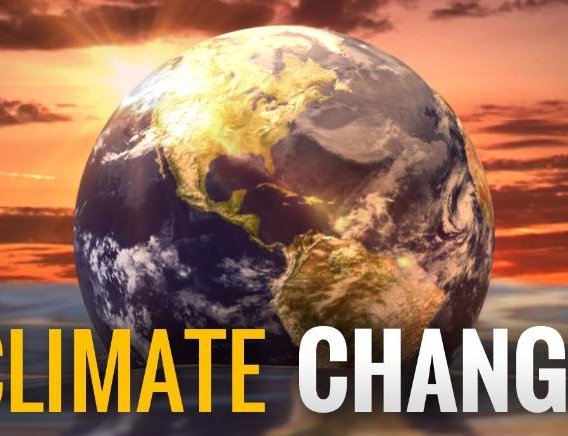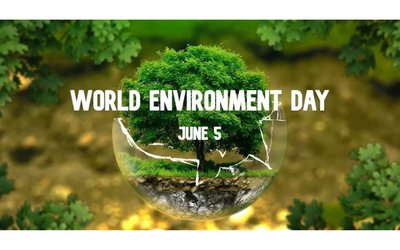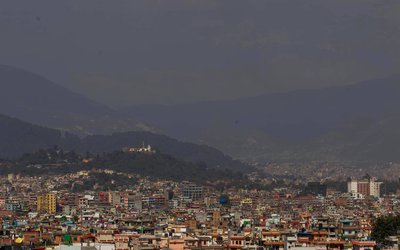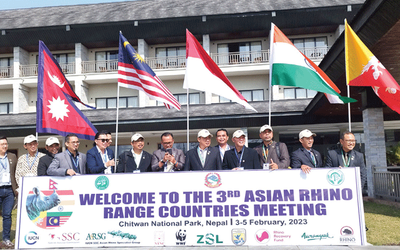
What is Climate Change?
Climate Change is not a fiction or a Hollywood’s drama sequel. It is real and already here. Let’s be serious it is about survival of humans and living organisms. It is about saving the Planet Earth, the eco-systems and biodiversity. To many deniers it sounds a radical thought. But if there are no living beings in this planet what is the purpose of saving the Earth?
The most important greenhouse gases, (a heat trapping gas produced by carbon dioxide CO2), related to global warming is produced by deforestation, burning fossil fuels and natural events. Seventy five percent of CO2 will not disappear for thousands of years. Thus, releasing fossil fuel CO2 to the atmosphere will last longer than we may want to imagine because carbon is there ‘forever’ impacting human civilization, or shall we say the ‘survival’ of generations. This becomes the top priority when we are not making significant efforts on reducing elevating global warming situation.
The weather changes are largely created by human activities causing in surface temperatures increase (i.e. global warming). The long-term rise in the average temperature of the Earth’s climate system is a major aspect of climate change. Climate change is a long-term global warming and weather is about local changes in the climate that we witness around us on shorter time scale. Global warming is about rise in average temperature of the Earth’s climate system and concomitant effects.
Why is Climate Change so Alarming?
Concentrations of greenhouse gases like water vapor, carbon dioxide, methane, nitrous oxide and ozone in the atmosphere absorb and remit heat radiation. Changes in the amounts of greenhouse gases in the atmospheric heating results in unpredictability of the weather and climate. This phenomenon will impact on the severity, scale and frequency of storms, draughts, wildfires, and extreme temperatures. Continued rising temperature will result in higher temperatures attributing to warming of the planet, rising sea levels, shrinking mountain glaciers, melting of ice, and shifts in plant life and flowering times.
Climate change is the most challenging confrontation of modern times for socio-political, sustainable development, economic prosperity and human survival. Extreme weather events will reduce productivity affecting individual’s ability to work. Inundation of floods and landslides will adversely affect life of millions contributing to increase in poverty and inequality. Draughts, floods, landslides and storms will destroy agriculture. Agricultural harvest will shrink. Hunger, malnutrition and diseases will rise, and human productivity is compromised as health deteriorates. Aggravating food supply situation will be a serious challenge of feeding growing global population and ensuing conflicts.
The expected effects of global warming have long-term multiple implications across all regions and all communities in varying proportions. Weather pattern could vary from one region to another due to varying level of rising levels of temperature changes and greenhouse gases which are not uniform across the Earth.
Climate change, single most existential human threat, is a global phenomenon and mitigating actions should not be confined to the limits of national borders in pursuing the global climate concern. Countries in both hemispheres, developed North and developing South, people are witnessing every day the wrath of nature’s calamities due to human-induced rising global warming. Evidences based on melting or forming ice, shifting the hydrological cycle (evaporation and precipitation), and changing currents in oceans and air flow into the atmosphere climate scientists suggest it is becoming an irreversible and calls for urgent attention on climate emergency.
It is stunning that political leaders have failed to agree on aggressive action plans on mitigating measures during the COP25 Madrid meet last year and in Davos 2020 earlier this year. What can we expect later this year at the COP26 in Glasgow is any body’s guess?
The Impacts of Climate Change on Nepal and its Vulnerabilities
Nepal is a beautiful country with majestic snow peaks, high mountains and stunning landscapes all around. But the mother nature can be cruel if we do not urgently take mitigating measures to reducing impacts of climate change, for she is not going to spare any one from impending wrath. Situation could be overwhelming for majority of Nepal’s population who live in rural areas and survive on small-scale agriculture. Water and forests are Nepal’s most important natural resources. All major rivers, the lifelines of Nepal’s agriculture, receive fresh water supply from melting snows and glaciers, and seasonal monsoon rainfall. Changes in the length, intensity and the amount of water flow in these river systems will adversely affect the population, eco-systems and biodiversity.
Nepal is one of most vulnerable countries to climate change in the world. Its major climate stressors are rising temperatures, increased floods, landslides and draught. Changes in the biodiversity and ecosystems are the direct impact of the climate events. One projection suggests average temperature rise in the tune of 3.8 degree Celsius by the 2060 to the tune of 5.8 degree Celsius by the 2090, with increasingly warmer spring and drier winter. This could result in significant variations in precipitation and bring torrential rainfall in monsoon, and summer floods and possibly drier winter months. Extreme weather events like landslides, floods from rapidly melting ice and snow in the mountains, which are part of global warming, could have devastating effects on the population living along the river basin. Draughts could also be expected in some parts of the country during winter months due to low rainfall and farming would decline.
Vulnerabilities arising from climate changes are of significant national concerns. These are in the areas of freshwater resources, environmental degradation, dwindling food production, poverty, hydropower energy, public health, infrastructures, forests, the ecosystems and changing biodiversity, and freshwater and food security.
Primary sources of household income are agriculture, livestock and employment in service industries and remittances. Any variation in climate will deteriorate the food supply situation because agricultural production is primarily based on monsoon rainfall. Currently, Nepal imports staple items like rice and lentil from neighboring countries. Nepal has now become a rice importing country. This vulnerability could gradually escalate into a full-blown national food security threat together with the effects of extreme weather events.
We now know irreversible climate change impacts on forests, grasslands, mountains, rivers and agricultural systems could be serious. Increased temperatures and fluctuating rainfall will bring more floods, landslides destroying infrastructures. There also will be higher incidence of pests and diseases. Draughts and forest fires will be a common feature. Draughts will deplete wetlands affecting loss of vegetation and aquatic species. Extreme floods and landslides will intensify soil erosion increasing vulnerability in farming and other means of livelihood. These weather events are already reoccurring through-out Nepal.
In recent year’s increased urbanization has exerted pressure on infrastructures, education, health services and rising cost of living. Reduced agricultural production, due to effects of climate change impacts, would result in low farm yields, supply of food, and diminishing household incomes. This perpetuating situation will increase never-ending rural poverty and availability of food supply contributing to malnutrition, hunger and disease.
Emigration is unstoppable due to inadequate investments in employment generating small and medium scale enterprises (SMEs), the key drivers of economic growth and sustainable development. This prevailing situation will continue to propel emigration. Urban poor is increasing, and poverty remains significant. This could further aggravate with the effects of climate change impacts. According to the World Bank estimate some 32 percent of the population live on incomes between USD 1.90 and USD 3.20 a day, not adequate for graduating to become low middle-income country.
Freshwater, received from glaciers, snowmelt and rainfall, feeds into country’s major rivers Koshi, Gandaki and Karnali, and smaller ones from monsoon rainfall. Importantly, the river systems serve millions of people living along the downstream, including in parts of northern India. Variability in rainfall together with Himalayan glacial melt could change availability of fresh water sources and alter the rosy picture of Nepal’s forests, agriculture, biodiversity, and hydro-power generation. Increase or decrease in rains would impact production of paddy, maize, and other seasonal cash crops.
Agriculture sector suffers from low productivity, lack of competitiveness and low adoption of technology and poor market access. The agricultural production is currently not at par with demand for growing population necessitating importation of food commodities. By one estimate, Nepal is now one of the highly food-deficient and ranks on the list of top 20 highly food-deficient countries in the world. This undoubtedly contributes to hunger, malnutrition and diseases in rural areas and most vulnerable women, children, poor and disadvantaged would perennially remain trapped in poverty cycle and disempowerment.
Nepal’s greenhouse gases emission is generally attributed to agriculture sector (50.1%) and energy (29.6%) and the rest from forestry and land-use (14.8%), industrial processes (3.6%) and waste (1.9%). Agriculture sector contributes carbon dioxide (CO2) emissions from enteric fermentation from livestock. The other CO2 emissions are from fossil fuel combustion in energy sector, forestry and land-use change, industrial processes and waste. Although Nepal is not a big polluter at the global scale because it contributes only 0.03% of the total global carbon emissions. This should not be a reason for being complacent in adopting effective mitigating measures.
Nepal is an energy deficient country. According to the Energy Access Diagnostic Report’s Multi-tier Framework Analysis (ESMAP or Energy Sector Management Assistance Program, World Bank Group) majority of household cooking energy is derived from the use of forest firewood (74%), dung (5.4%), crop residue (4.9%), charcoal (0.2%), biomass (0.2%), saw dust (0.5%), liquefied petroleum product (34.9%), biogas (3.0%) and electricity (0.45). These greenhouse gas sources, generating CO2, can be reduced by harnessing hydropower sources, a major source of clean energy.
The present approach to development of hydropower energy, harnessing for domestic consumption and exporting the surplus has failed to make impact on the use of clean energy and economic development. Interestingly, Nepal has the lowest electricity consumption in the world and the reasons for this are manifold, an important issue for a separate topic of discussion.
Nepal has 83,000 MW of theoretical and over 42,000 MW of financially viable hydroelectric potential, but so far less than 1,000 MW is installed capacity. Current low domestic demand of about 2,000 MW is an indication of absence of economic prosperity and lack of sustainable industrialization. This demonstrates inability of the governments to maximize the nature’s gift for the prosperity of the nation. Insignificant domestic energy market is an impediment for maximization of growth potentials. Maximization is feasible only with partnerships with willing countries with large energy markets. But it would require conducive policy framework guaranteeing foreign direct investments in developing clean energy, cross border transmission and stable energy market environment.
Hydropower, energy production is vulnerable to climate change impacts. Increased floods are likely as warming occurs and glacier-fed rivers rise. And again, as loss in glacial melts and evatranspiration continues unabated with atmospheric heating availability of amount of water would reduce. This would impact in the future viability of hydropower potential. This possibility is not a fictional imagination but a reality as thousands of climate scientists predict and have reminded us that global temperature has already risen by 1.1 degree Celsius from pre-industrial level, and again, by 1 degree Celsius in the past decade – much faster occurrence than scientists’ earlier prediction. This is now a climate emergency and not a time for complacency.
Just imagine if there were a combination of extreme climate events occurring due to rising global temperatures, as climate scientists predict, impacting on extreme storms, glacier melts, avalanches, heatwaves, floods, landslides would drastically escalate the situation and Himalayan biodiversity collapses. This phenomenon could suddenly devastate agricultural production resulting in supply of food shortages, availability fresh water and increase in incidences of diseases due to rising temperatures. Let the reader imagine what the probable consequences would be of this Apocalypse in the making. I would not want to speculate beyond unimaginable loss of human civilization and survival of the Planet Earth.
Challenges are real. Where to export surplus energy? Who would invest in development and transmission? Who would be the potential buyers if we are to continue with the likes of toxic debate ensuing the MCC grant meant for development of infrastructures and power transmission lines for export potentials? Surely, investors would not be impressed by such political euphoria and short-sighted narratives on matters of foreign investments and economics of development.
Freshwater resources could create future fissures between those who have access to freshwater and those who do not have the resources. Human civilization is built along the banks of mighty rivers, any disruptions to availability could complicate relationship between neighbors. If effects of climate change impacts continue to grow water related fissures with India is a distant possibility, as if Koshi and Mahakali inspired periodic eruptions were not enough. Let’s not forget reminding ourselves that India’s underlying interest in Nepal could also be in future sharing of river-fed freshwaters. India is a water thirsty, energy hungry country aspiring to become a significant economic powerhouse (fifth largest world economy – surpassing France and U.K.) and global political player.
World witnesses a series of water related disputes between nations. One serious and intractable on-going water dispute, now, is over water sharing from mighty river Nile involving Egypt, Ethiopia and Sudan. Likewise, conflict in the Middle East has a significant element involving sharing of Jordan river water between Israel and Syria, Jordan and the Palestinian Authority. Water is a gift of nature, but water thirsty nations are demanding equal rights to access. India Pakistan dispute also has an embedded element of river waters flowing from Himalayas through Hindukush into Pakistan, Afghanistan and India.
Nepal faces challenges, unlike others, in energy sources despite having huge hydropower potentials. As climate change impacts intensify in coming decades, as predicted by computer modelling, Himalayan glaciers (including in Tibet region) are melting faster than previously thought and freshwater lakes could dry up faster due to global warming. This should be alarming to the countries in the sub-region which derive freshwater heavily and feed into mighty rivers emanating from Himalayas. This signals that in the long-run hydropower energy production will not be elusive as it is now and, when mighty rivers recede and demand for water for domestic use and agricultural purposes develop into serious challenges for growing population.
It is disappointing that political parties and government in power are busy polarizing population by pointing fingers either at India or China or USA as the enemies of the nation (depending on which sides of the aisle one belongs to). There is hardly a national consensus on how to develop economy and achieve economic progress at par with other developing neighboring nations. Political parties are trumpeting pseudo-national patriotism and dumping their leadership failures on foreign countries. Patriotism is not about blind loyalty to political party or individual leadership, but it is to the nation.
What is amazing is that government, bureaucrats, political parties and other influencing elites have failed to see the real enemies like poverty, hunger, malnutrition, superstitions, inequality, ignorance, misinformation and disempowerment of the population. When can we expect anything better in the polarized environment for sustainable efforts towards mitigating measures to reducing impacts of climate change without misleading the population?
Unintended consequences of failing to realize probability of future water shortages would mean our collective inability to harness surplus energy potentials for right economic gains for national development. Sales proceeds could have been invested through a Marshall Plan into infrastructures, connectivity and agricultural development for regional comparative advantages in manufacturing and supply value chain. National development funded through revenues generated from export of hydropower is a real possibility, like Gulf countries have achieved through sales of fossil fuels; provided there are willing buyers of surplus energy against a reality - Nepal is, more or less, geographically India-locked country.
Both India and China have aggressively pursued development goals and swiftly harnessed domestic growth advantages from open market trading system. Result: China produces one third of global manufacturing goods. India serves as the prominent technical repository in innovation and information technology development - dominating the niche market. This transformation is so trendy that grouping of unlikely similar economies and countries with different political systems like Japan, South Korea, Australia, Malaysia, Singapore, New Zealand and EU are pursuing improved trading ties with India and China simultaneously under the RCEP (Regional Comprehensive Economic Partnership). We, in Nepal, are still in deep cold water, not knowing where the warm water is flowing from and where to?
Conclusion:
Development of hydropower energy could substantially reduce greenhouse gases emission. It is crucial that hydropower potential is fully harnessed with some urgency and marketed for investment in economic sustainability before Himalayan meltdown increases in foreseeable future. Nepal should aim to become a carbon negative (but, not by carbon trading) through the development of clean hydropower energy without delay. It would require revisiting current energy policy framework and shift to technically viable large-scale hydropower projects providing affordable hydropower energy to the entire communities and aiming at becoming real carbon negative country while also benefiting from improving quality of life and economic advantages. Development of hydropower could, thus, enhance in climate adaption and to resilience capacity of local communities.
Energy policy has stumbled in adapting to rapid development in a very competitive global trading environment due to lack of realistic economic vision combined with political pragmatism of 21st century. This nation has become incapable of seeing through the pragmatism of maximizing potentials from accrued benefits of comparative advantages of economic synergies with neighboring economic giants of this century. The Result: Despite being one of the richest in freshwater resources Nepal remains one of the poorest countries and slowest-growing economies if compared with other Asian neighbours. Per capita income is also rapidly eroding in comparison to other growing Asian peers. This signal, despite government claim, that Nepal is unlikely to graduate from low-income status to the next middle-income level anytime soon by any sustainable standards.
If present energy growth stagnation continues without pragmatic shifts and remain stuck in current economic narratives of euphoric falsehood, and if this situation coupled with combined effects of the increasing threats of impacts of climate change Nepal’s survival as an economically sustainable state is unimaginable, just not only as a ‘failed state’. If Nepal could not benefit from partnerships with groupings of multiple alliances (not political non-alliance) and harness the growth potentials just as fast, with radical shifts in thinking beyond the present nationalistic posturing - it could otherwise become an existential irrelevance to nationhood of any economic significance.
Kedar Neupane is a founding board member of the Nepal Policy Institute, a retired senior UN official, and president of ‘We for Nepal’ association based in Geneva, Switzerland. He has worked in several countries in Africa, the Middle East, Asia and Europe in his 38 years of service with the UN system and was Senior Change Management Advisor to UN High Commissioner for Refugees. Email: Neupanek1950@gmail.com

Kedar Neupane
He can be reached at Neupanek1950@gmail.com
- Talking About South Asian Diaspora Community And Its Economic Prowess In The USA
- Aug 23, 2023
- Talking About Growth Miracle And Emerging Quadripolar Economic Construct (Part – Two)
- Jul 28, 2023
- Talking About Growth Miracle and Emerging Quadripolar Economic Construct (Part – One)
- Jul 02, 2023
- Pseudo-Nationalism Is About Political Desperation And Sure Sign of Economic Collapse Context And Background
- Jun 19, 2023
- Realities In Conflict Of Interest And Challenges Of Combating Corruption In Nepal: PART -TWO
- Jun 08, 2023
















